Nolina is a succulent, whose homeland is the south of the United States. In our area, it has become widespread as a houseplant. His popularity was promoted by unpretentiousness in leaving and an attractive look. Caring for nolina at home is quite simple. The main thing is to pay due attention to the plant from the very beginning.
Material Content:
Varieties and varieties
A feature of plants of this species is the “inflated” base of the trunk, where water accumulates. Under natural conditions, it is this feature that allows the succulent to survive during a drought. The bark is similar to the skin of an elephant, in addition, it does not let moisture out. Narrow and strong leaves in a period of drought gather in a bunch, reducing the evaporating surface.

There are many species of nolina, or bokarney, but isolated varieties are grown as a decorative plant.
The most common types:
- Bent away. Has a straight tree stem with weak branching. Leathery leaves form a thick rosette. In nature, blooms in panicles of a creamy pink hue.
- Longleaf. In its homeland, this tree grows up to 3-4 m. The bark is thick, cork-like. Old leaves form the so-called "skirt" that hides the base of the trunk.
- Lindemeira. Short stature without a pronounced trunk. It has strong long leaves.
- Stamp. It is a small tree with a short trunk, resembling a bottle. Foliage is collected in thick sockets.
- Matapskaya. The maximum height is 1.7 m. Old, outdated leaves do not fall, but remain hanging, also forming a “skirt”.
As a houseplant, most often grown bent turnip.
Nolina: the nuances of growing
This plant is good in that during a long absence of hosts it will not dry out and will not discard leaves. Therefore, for busy people the best landscaper can not be found.
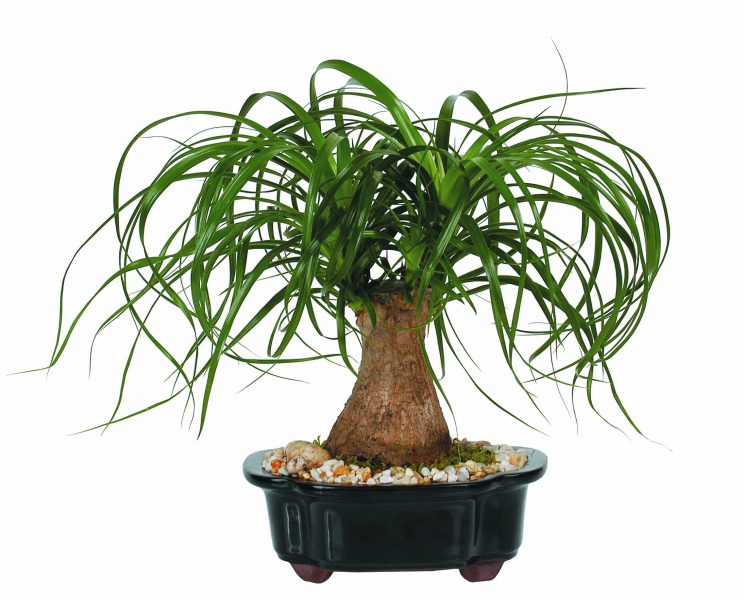
Of the nuances of growing, you need to mention the following points:
- Between watering needs drying. Excessive moisture can kill the plant. It is better to dry than pour.
- The ideal container for growing is a low ceramic bowl. The root system is branched, but superficial, so the plant will feel good in such a pot.
At home, succulent blooms very rarely.
But it well enriches the air with useful substances.
Therefore, it is often grown not only in private homes, but also in kindergartens, offices, hospitals.
Home Care
Nolin flower feels best in a well-lit place, but without direct exposure to midday rays. In the cold season, the plant may suffer from a lack of light, so it requires additional illumination with lamps. You can not keep a flower in a draft or near an ajar window, from where cold air blows.

The optimum temperature in summer is from 21 to 25 ° C.
In the warm season, the flower can be taken out into the street in a bright and quiet place without drafts. The main thing is that rain does not get on the plant. In winter, the temperature should be gradually lowered to 10 ° C so that the flower enters the dormant period.
For a city apartment, this plant is the best fit, as it will not suffer from dry air. Succulents are not at all demanding on this parameter, therefore their leaves are enough to wipe them with a damp cloth from dust every 3 to 4 weeks.
- It is important to know that excess moisture is harmful to the tree. Therefore, watering is carried out within reasonable limits.
- It is best to just fill the pan with water - then the plant will take as much moisture as it needs.
- Watering is necessary only when the soil is completely dry.
- During dormancy, the flower can be watered at all. In nature, an adult tree can withstand drought for 10 to 11 months, gradually spending water stored in the trunk.
Top dressing is needed only in the warm season. Every three weeks, the plant is fed a weak solution of mineral and organic fertilizers.
Nolin flower transplant
Young trees are replanted every year, as they grow rapidly. For 6 - 7 years they turn into large floor plants.
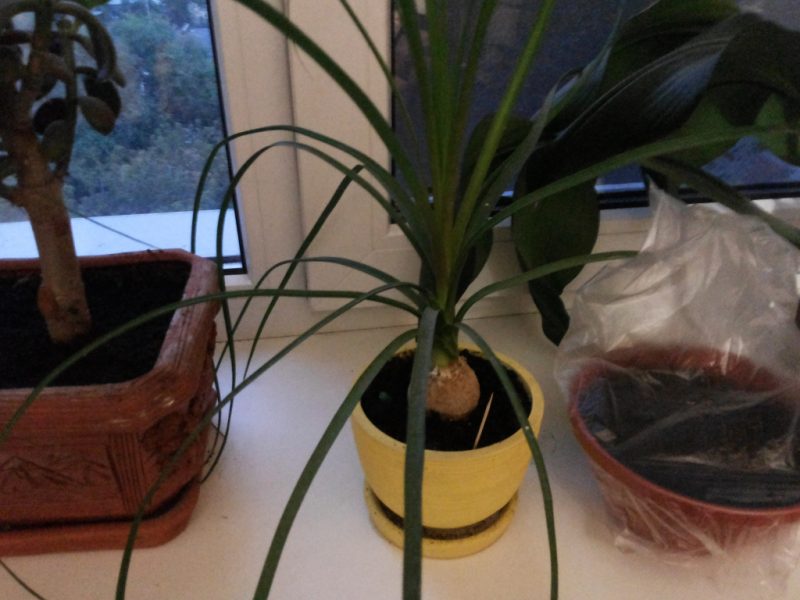
Adult nolins are transplanted every 3 years. To understand that a succulent needs a transplant is simple: it slows down growth, and the roots begin to climb from the drainage hole. Since the root system of the plant is superficial, wide containers are most suitable for it. The diameter of the new pot should be 3-4 cm larger than the old. Be sure to make a hole for the drain and lay out a decent drainage layer to avoid stagnation of water and decay of the roots.
The soil mixture should be loose, so be sure to add peat and sand.
You can buy a special ready-made substrate for nolin or use any soil mixture for succulents. When transplanting, you need to ensure that the thickening at the bottom of the trunk is not covered by ground. Only the roots are carefully sprinkled with soil.
Flower propagation methods
Propagating the plant is quite easy. Most often it is propagated by seeds or lateral offspring. In any case, a flower grown in this way adds very slowly in growth.
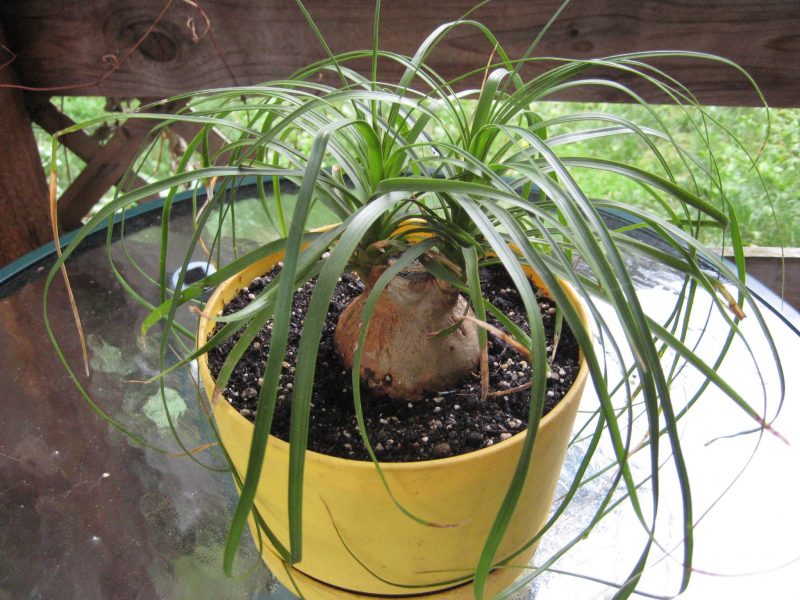
- Before sowing, you need to disinfect by soaking the seeds in a warm solution of potassium permanganate for 48 hours.
- Then they are sown in prepared boxes to a depth of 1 cm, watered, covered with a film and put in a warm place.
- Seedlings germinate in 15 to 20 days.
- Slightly grown seedlings are planted in separate pots.
Sometimes, under the thickness of the cortex, sleeping kidneys are activated, which give lateral shoots. It is important not to miss this moment and cut the process as close to the base as possible.The offspring must be dried, then dip its base in the phytohormone and place in the substrate in an inclined position. It is advisable to cover the process with a transparent container.
Diseases, pests and care during this period
Most often, scabies and thrips affect the scab. They settle on leaves that turn yellow and fall off over time. Parasites must be removed with a sponge dampened in soapy water. After the procedure, spray the entire plant with “Karbofos”.
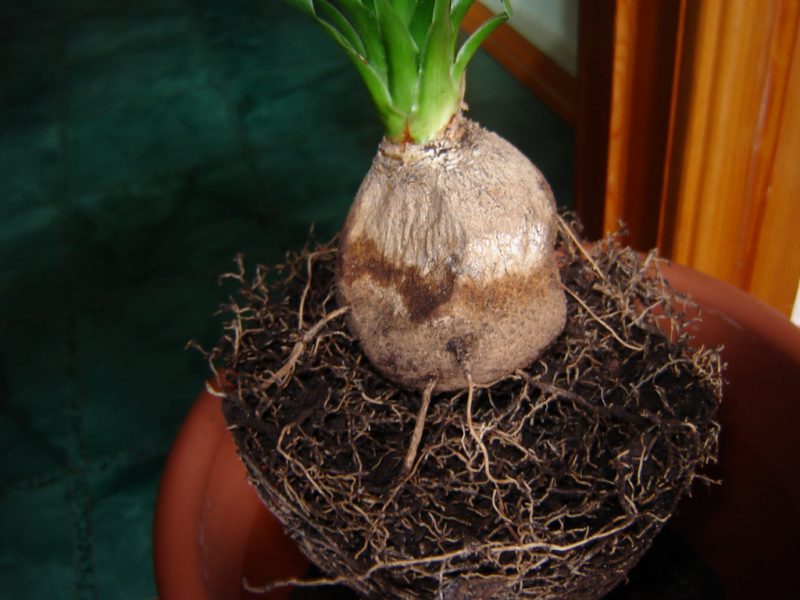
To prevent the appearance of pests, you need to keep the plant clean and regularly wipe the leaves.
Problems that flower growers may encounter
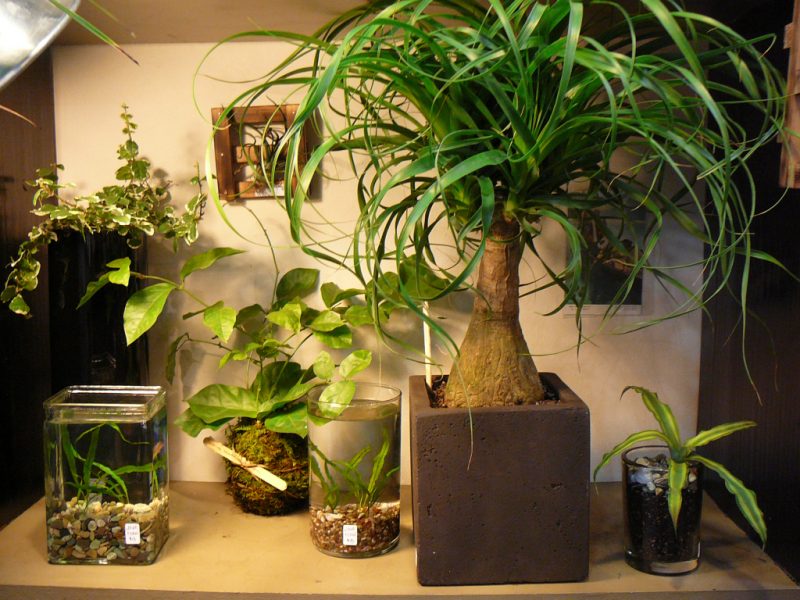
- If the leaves grow very slowly, this indicates a lack of nutrients. The plant needs to be transplanted or fertilized.
- For the same reason, the leaves may fade and fade. This is easily eliminated by creating more suitable conditions for the plant.
- Sluggish and drooping leaves indicate insufficient lighting. Move the pot to a brighter place.
If the trunk becomes soft, this is a bad sign. On the face, the rot of the stem from excess moisture. Most likely, the plant will die.
You can try to save the flower until the rot has spread to the whole plant. To do this, cut off all the rotted parts, treat the sections with activated carbon and transplant the plant into a container with dry soil. After that, it is forbidden to water the succulent for 1 - 1.5 weeks.
Do not worry if the lower leaves begin to dry and fall off. This is a natural process, it is enough to remove them in a timely manner. If the trunk has dried up or become too wrinkled - this is not scary, just the moisture reserves have come to an end and you need to water the succulent.
There is nothing complicated about growing nolins. This unpretentious flower looks great in the interior and feels good in a city apartment. It is best suited for landscaping apartments in contemporary styles.












